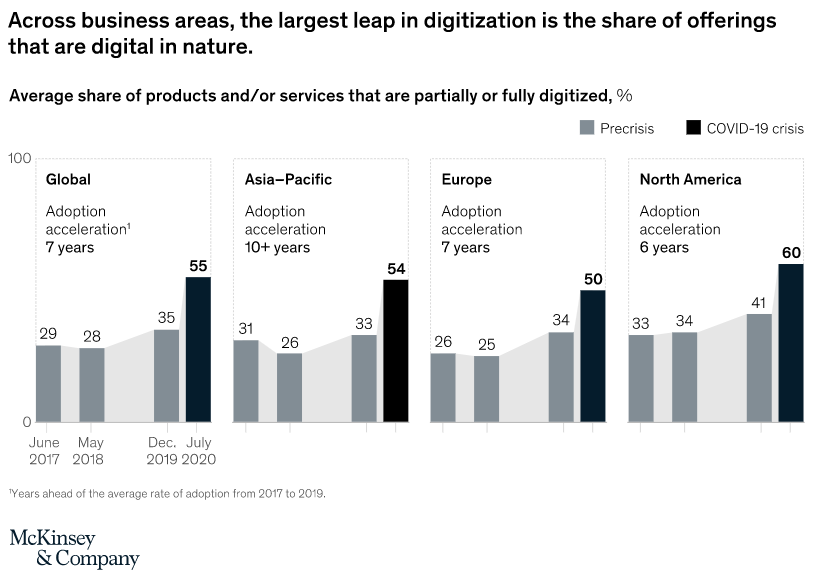Let us know what type of content you'd like to see more of. Fill out our three question survey.
What Are We Reading about Digital Transformation and COVID-19?
Mar 4, 2021
I find it difficult to use the word in this context, but there may be one positive—if not collateral—effect of COVID-19: after the decades of support the digital development community has provided to businesses and consumers around the world to help, the adoption of digital technologies has accelerated in mere months. There’s a new willingness to embrace the digital economy, as restrictions against in-person interactions move people online and require the use of digital tools out of necessity. This process, often called digital transformation, has been discussed by a variety of sources, outlining both its benefits and risks. We thought it might be helpful to provide an overview of some of the articles, blogs, and resources we are reading to leverage this momentum. This list is by no means exhaustive, but rather provides a few highlights to get you started. I’ve broken down the readings into three, highly academic categories: 1. This is really happening, 2. and the benefits could be huge, 3. but please do not forget the risks.
This is Really Happening…
All you need to do is search “digital transformation of the economy” to quickly find data demonstrating the rapid pace at which digital transformation is happening. McKinsey released a study showing that the rates of adoption are years ahead of the average rate, stating that “respondents are three times likelier now than before the crisis to say that at least 80 percent of their customer interactions are digital in nature.” This phenomenon is especially true in the Asia Pacific region where the study affirms that adoption has been accelerating by 10+ years.

Forbes similarly cited a study reporting that 97 percent of executives said the pandemic sped up their digital transformation; 95 percent said they’re looking for new ways to engage customers; and 79 percent said COVID-19 increased budgets for digital transformation.
…And the Benefits Could be Huge…
The rapid rate at which businesses around the world have been adopting digital technologies has led to benefits beyond what we could have predicted. The United Nations Department of Economic and Social Affairs published a report called “Frontier Technology Issues: Can digital technologies put us back on the path to achieve the SDGs?” that discusses how technology adoption in a post-COVID-19 world is actually helping accelerate achievements toward the Sustainable Development Goals (SDGs). First, it outlines how digital technology adoption has contributed to the evolution of labor markets, generating new opportunities in decent work, enabling remote work, and actually helping people transition to new jobs and industries. Second, it dives into the use of technology to improve health services and outcomes. No one will debate that COVID-19 has disrupted health systems across the world, but it also forced health providers to adopt new tools such as telemedicine to reach their patients. Lastly, COVID-19 has forced education systems to rethink learning, which, while a major concern, has shown the power of digital tools in enabling education to continue through both high-tech and low-tech solutions, such as TV, radio, and mobile phones. This report does not ignore the challenges posed by COVID-19 in these three areas nor the growing digital divide, but rather provides a perspective on how digital transformation of the labor market, healthcare, and education are important to recognize.
Another blog by United Nations Development Programme talks about how digital transformation can and will lead to a greener economy. The piece discusses the technology trends that are picking up steam: drones that map disaster risks, spatial data on forest management efforts, and fintech solutions that encourage sustainable activities. The blog goes into more detail on examples across the globe, from the GCash Forest Platform in the Philippines to the use of a cryptocurrency in Lebanon that plants a tree for every coin purchased.
…But Please Do Not Forget the Risks
While the rate of digital transformation is exciting and demonstrates the potential for lasting change in the use of digital technologies, many resources—including those listed above—also outline the risks associated with this change. Going digital is in no way a panacea to the effects of COVID-19 on the global economy and broader social systems. Equally as important, is the ever-growing digital divide. Countries and communities left behind in the gradual shift toward digital technology risk being further disadvantaged during this seismic shift. A great resource on this topic is the United Nations Economic Commission for Europe and the Portulans Institute’s Network Readiness Report Index 2020: Accelerating Digital Transformation in post-COVID Global Economy. It discusses how as a region Africa continues to struggle with improving access, affordability, and usage of internet and digital tools, and that the “ripple effect” of pandemic-related digital transformation on the global economy will enhance “divergences between network-ready economies and laggards.”

Source: UNDP Digital Strategy
If we dig into one portion of the economy—micro, small, and medium-sized enterprises (MSMEs)—we also see this widening divide. The World Economy Forum published an article titled, “COVID-19 Has Intensified the Digital Divide” that talks about MSMEs around the world that have relied on face-to-face interactions to do business and now have to adapt at a rapid pace when internet access is limited and the costs of digital tools may be prohibitively high. “Suddenly, access to technology became another source of inequality and vulnerability for millions of small retailers in our value chain” and many MSMEs were not able to connect to consumers and meet the digital demand.
These are just a few of many resources and reflections on digital transformation in a COVID-19 world. More studies are being done every day to determine the long-term effects of this shift in economies around the world. Stay tuned!